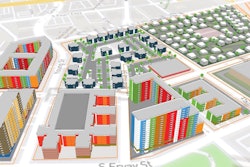
The pandemic and its many side effects continue to disrupt the construction industry, with supply chain and labor shortages delaying projects nationwide. Despite strong buyer demand, with an estimated 500,000 jobs presently open in the industry, homebuilders are limiting sales orders due to their inability to keep up. Analysts expect fewer single-family starts to occur this year.
With so many industry-wide challenges, it is imperative for general contractors to retain the subcontractors they work with. GCs are able to build and maintain good relationships with subcontractors, which starts with paying them not only on-time, but quickly—increasing retention. While the industry is facing many headwinds, there is an element of construction finance that is having a positive impact in keeping subcontractors happy: the speedier movement of money. Here’s what general contractors need to know about the benefits of digitizing construction payments and documentation to maintain the services of subs during these times of disruption.
Communication is Key
Communication plays a large role in building a solid relationship with subcontractors. To start, there can be different sets of requirements when working with different general contractors, such as GCs based in different locales. Detailing these needs up front and making them transparent to subcontractors is beneficial and helps build trust.
Collecting proper compliance documents upfront is a key part of this. Unfortunately, construction finance is often hampered by the need to track down individual invoices, lien waivers, compliance documentation, information about subcontractors, and so on. Crucial documents that typically need to be accounted for when subcontractors submit invoices include whether they have obtained a W-9 and proof of insurance for the subs during the timeframe that they did the work. Collecting these documents early will help ensure a smoother process for everyone involved. It is frustrating for subcontractors if they have to dig up proof of insurance from nine months ago in order to get paid.
Speed Through Digitization
A digital platform for payment documentation and management technology can help track all these documents and ease communication with subs. These platforms bring together all stakeholders in commercial and residential construction—lenders, owner/developer, general contractors, subcontractors, and diligence providers—to streamline historically manual processes that have long slowed construction finance. By digitizing construction financial processes, technology removes tedious data entry and Excel spreadsheets upkeep, providing a much more efficient means to manage documentation processes.
By leveraging a centralized platform for all stakeholders, subs know that when they send an invoice, it isn’t the start of a process that is going to entail six other actions in order for them to get paid. For example, when you receive an invoice from someone and need a lien waiver, it’s common for the invoice to be accompanied by a conditional lien waiver. When contractors get paid, they have to send an unconditional lien waiver for that payment—and this all happens via lots of back-and-forth email and obtaining notarized signatures. With construction-specific technology, these extra steps are avoided. A system providing full visibility and transparency into all project-related documentation enables contractors to get funds from the bank on time so that they can then pay their subcontractors in a timely fashion.
The Bottom Line
In a tough environment and uncertain economy, a contractor is both a salesperson and a service provider. But they don’t want to be salespeople. Their preference is to be booked months in advance and consistently earning money, moving from one job to another without having to be interrupted to “sell” their services.
Timely payments are one of the easiest ways to maintain good relationships with valuable subcontractors and suppliers. Late payments and complex payment cycles eat up more of their profits and slow down projects, which harms everyone involved. As a general contractor, how do you keep those subs happy? You keep them paid and keep them busy. What some GCs and project owners fail to do is put themselves in the position of the subcontractor, who has completed the work and just wants to get paid. Subs are drawn to companies that pay on time, so having all project details and documentation transparent and available in real time leads to faster payments and keeps all stakeholders happy and informed. Making sure to obtain documentation at the right time and keeping track of it digitally is critical to all construction stakeholders and is a huge time saver on the way to faster payments.


















